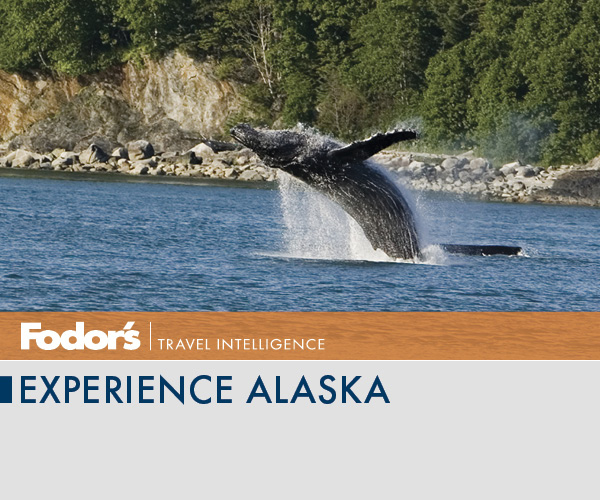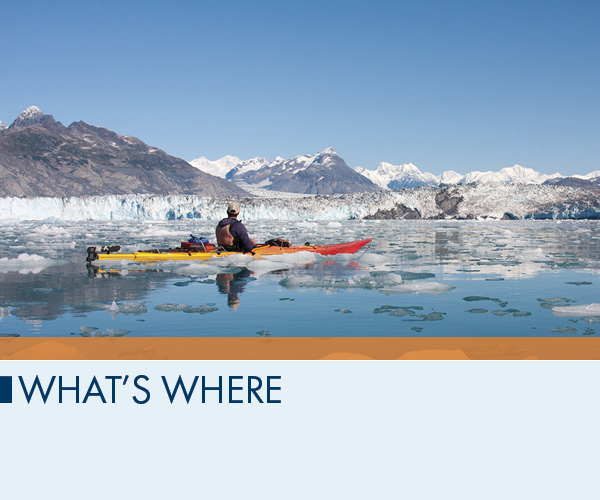

The Alaska Wilderness
Southeast Alaska
Anchorage
South Central Alaska
The Interior
The Bush


Southeast Alaska. Southeast Alaska (or the Panhandle) includes the Inside Passage. Here youll find Juneau, the state capital, and Sitka, the former Russian hub. Haines and Skagway are the only towns along the water route that have roads to the Outside. A boat trip through the Alaska Chilkat Eagle Preserve will take you into wilderness that draws about 4,000 eagles to the area. Along this passage, fjords snake between the mountains, timbered slopes plunge to rocky shores, and marine life abounds.
Anchorage. With nearly half the states population, Anchorage is Alaskas biggest city and a good jumping-off point for visitors. The restaurants, art and history museums, copious espresso stands, and performing arts have earned the city the sobriquet Seattle of the North. Alaskans often deride the place as Los Anchorage, but the occasional moose ambling down a street hints at the nearby wilderness.
South Central Alaska. South Central offers great fishing, hiking, rafting, and wildlife viewing. Visit Seward and Homer on the Kenai Peninsula. Kodiak, in the Gulf of Alaska, is known for its green-carpeted mountains and brown bears. Charter outfits take you to remote wilderness spots. The summer crowds can be daunting, but a little research will take you to areas of true wilderness.
Denali National Park. Home to Mt. McKinleythe highest peak in North AmericaDenali National Park and Preserve comprises 6 million acres of Alaskas best wildlife, scenery, and adventures.
The Interior. Bound by the Brooks Range to the north and the Alaska Range to the south, the Interior is home to Denali National Park and Preserve. The regions major city is Fairbanks (gateway to the towns of the Arctic), the Bering Coast, and Canadas Yukon Territory.
The Bush. Many call the Bush the real Alaska. Inupiaq people share the tundra with the Prudhoe Bay oil fields. Brown bears roam Katmai National Park. Volcanoes shake the Alaska Peninsula. Prospectors still pan for gold in Nome. Except for the Dalton Highway and a few short roads near Nome, the region is essentially roadless. Traveling here requires planning; the reward is true adventure.

Politics
Alaskas politics and policies seem as wild as its vast, untamed acres. This is partly due to the fact that the largest state in the nation comes with a seemingly limitless supply of natural resources, and with them come conflict and controversy. Alaskas politics are thus saddled with numerous fiscal and environmental responsibilities, none of which are easily met. As a state that is often overlooked in the political media, it caught the public eye in 2008 when then-governor Sarah Palin was tapped to be the running mate for presidential candidate John McCain. Since then, Alaska has stayed in the limelight.
Gas and mining corporations have enormous influence on public policy in Alaska, but not without rivalry from environmentalists and subsistence advocates. There are ongoing and highly publicized battles over the proposed Pebble Mine project and the Donlin Gold Mine. If built, they could be the largest copper and gold mines in the world. Supporters claim they will bring much-needed jobs to local Native populations. Opponents say they will irrevocably pollute the lakes, rivers, and surrounding terrain (not to mention, near Pebble Mine project, swaths of Bristol Bay), destroying the fishing industry and other subsistence ways of life on which local populations rely.
Rapidly gaining national attention is the Arctic National Wildlife Refuge (ANWR), 19.2 million roadless acres supporting 45 species of land and marine mammals, 36 species of fish, and 180 species of birds. ANWR is in the northeast corner of the state and has been dubbed the Last Great Wilderness. The only way to get there is by bush plane. Area 1002, 1.5 million acres along the refuges coastal plain, has long been a subject of controversy, as it is thought to contain a large supply of oil.
From the Iditarod to cabin building, everything in Alaska is steeped in politics. This is inevitable, as there are more politicians per capita than police officers.
Economics
More than 75% of Alaskas revenue is derived from oil extraction. The state is also the nations leader in commercial fishing, but ranks dead last in number of farms and farm products. There is very little manufacturing in the state. Thus the cost of manufactured goods, produce, and other foodstuffs is considerably higher than in other states.
Because Alaska is predominantly composed of rural villages, thousands of miles from any distribution center, the cost of living is relatively high. In Barrow, for instance, one can expect to pay $10 for a gallon of milk.
The Permanent Fund Dividend (PFD) is a sacred check that Alaskans receive once a year, and for many in the Bush it can be a lifesaver. In 1977 the fund was created to receive 25% of Alaskas oil royalty income. It was designed to maintain a state income even after the reserves had been tapped out. Residents receive a check every October in amounts that vary from year to year, but are in the ballpark of $1,200. For many who live in the Bush, this stipend helps heat their homes in the winter. Every bit helps; rural and remote Alaska has seen heating fuel go as high as $10 per gallon.
Global Warming
In Alaska few people disagree that the glaciers and permafrost are melting; its just a fact. It is what to do about it that has politicians and constituents bickering.
Next page
















